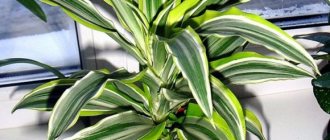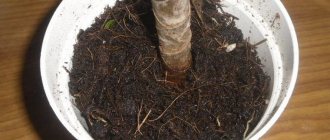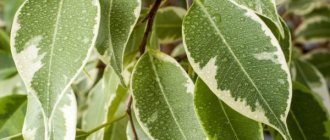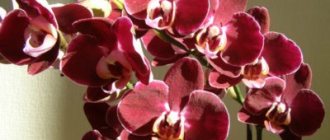Unfortunately, not all plants that grow to the ceiling can be dealt with. Some of them will have to be donated, given away, sold or shared with a neighbor above, if, of course, he agrees to this. When a plant reaches the ceiling, something naturally needs to be done. And, of course, the idea will come to your mind to shorten it, trim it to the desired height. But not all plants can be shortened. Some plants, especially those living in the humid tropics such as palm trees, cannot be pruned. In them, stem growth occurs due to the same apical bud throughout their life. By cutting off a vital “growth point”, we doom the plant to death. But those plants that can use new lateral buds every growing season can and should be pruned. These are all those plants that are easily propagated by cuttings. Let's look in more detail at what can be shortened and how.
So, we remember that the tops of palm trees cannot be cut off; they only need sanitary pruning. The most common palm trees in our homes are: Robelena date, Canary date, chrysolid carpus, howea, chamedorea, chamerops, coconut palm, livistona, rapis. By the way, you can limit the growth of some palm trees, for example, chamedorea, by replanting the plant in the same pot and replacing only the soil.
At home, dracaena, yucca, dieffenbachia, ficus, hibiscus abutilon, coffee tree and schefflera can also easily grow to the ceiling. All these plants can be shortened by following the general and specific rules for pruning indoor plants. We are specifically interested in formative pruning to control plant growth. And the best time to carry it out is spring, the time when active plant growth begins.
Dracaena and yucca are pruned in approximately the same way. Trimming the top of the dracaena to produce side shoots is not difficult. Using a sharp tool you need to trim the dracaena trunk at the desired level. An even cut is immediately sealed with either garden varnish or paraffin. The trunk below the cut is exposed to at least 10 cm of leaves. The upper part of the bare trunk is carefully wrapped in damp sphagnum moss (the cut site remains open) and wrapped in a transparent plastic bag. The plant is placed in a bright place for about a month. The bag must be removed periodically to moisten the moss and inspect the trunk for new shoots. As soon as the shoots appear, the moss and bag are removed and the plant develops without outside help. This way you will reduce the height of the plant and get a more compact bushy flowerpot. Trimmed cuttings can be used for rooting and further replanting, thus creating tiers.
Very often you can see in offices and buildings a dull and spreading Chinese rose, with almost all the branches bare and one or two flowers lost somewhere. Hibiscus easily tolerates all types of pruning, and formative pruning is even mandatory for it. The same applies to abutilone or indoor maple. Moreover, hibiscus blooms on young shoots no older than three years. If you regularly cut off all bending branches and shorten the main branches in the spring, the more compact and dense your plant will be, and the number of flowers will delight you with its abundance. Hibiscus can also be pruned immediately after flowering.
the rubber ficus will only grow upward until it hits the ceiling. You need to trim the top of the ficus to the desired level. You will stop its upward growth and force it to decide to branch laterally. The result can be a nice bush. Working with a sterile instrument will not necessarily process the cut. It is enough to blot it with a damp cloth or sterile bandage. The secretion of milk will soon end, and if it gets on your hands, rinse it thoroughly with water. Other types of ficus (Ficus Benjamin, Ficus Ali, Ficus microcarpa) have a good tendency to branch, but if, nevertheless, the apical bud dominates the axillary ones, they need to be trimmed or pinched in a timely manner.
Dieffenbachia tolerates pruning well . Its cuts must be sprinkled with crushed coal to prevent rotting of the stems and fungal infections. All care work with Dieffenbachia should be carried out wearing protective gloves and protecting your eyes from getting the poisonous juice of the plant into them.
If these are vines with flexible stems, such as monsteras, philodendrons and others, which grew attached to a vertical support, then they can be detached from the support and redirected in other directions. You can also cut them to the desired height, and try to root the cut parts.
Trimming time
The dracaena stem is a structure in which dormant buds are arranged in a spiral along its entire length. This is what makes it possible to obtain seedlings and the beginnings of new branches from a cut made in any part of the trunk.
Planned pruning of dracaena is done during the active growth period, when sap flow is best. There are times when the formation of a bush is needed urgently. For example, part of the stem broke off. Then the shortening must be carried out according to the rules, below the break point. Any pruning can only be effective on a healthy plant.
Dracaena: plant propagation using apical cuttings
So, your dracaena has become ugly, has ceased to be attractive, do not despair, it can be brought back to its previous state, you just need to pay a little attention to it.
Take a sharp knife and cut off the top of the plant along with the leaves. The cut should be perpendicular to the trunk and at a distance of 15-17 cm from the last leaf. Clean the stem from the remains of leaves and old foliage, that’s it, the seedling can be considered prepared for planting. All that remains is to dry it a little at room temperature for three hours.
Cuttings for rooting can be produced in several ways:
- placing the cuttings in water, to which you need to add charcoal or a drug that stimulates root formation;
- placing the cuttings in a mixture of peat, sand and crushed coal;
- placing the cuttings in a container with vermiculite or perlite, at the request of the grower;
- placing the cutting in a container with steamed soil mixture specially produced for dracaenas, palm trees and other types of exotic plants.
Watering is also carried out very carefully and in doses. The roots of a plant can rot from too much water and dry out from a lack of it. The grower will have to balance to avoid either one or the other. Use only warm water, at room temperature, at least + 20 degrees. It is left to stand for about a day, and only after that the cuttings are watered and sprayed. Dracaena is very good at irrigation; using this method you can not only water, but also feed the plant.
Do not throw away the remaining stem with roots; it can also be revived and grown into a full-fledged beautiful plant. Just cover the stem with a bag and put it in a warm place, of course, water it periodically. After about 30 days, side shoots will begin to appear on the trunk, which will soon turn into full-fledged branches. The updated dracaena will be able to continue its existence as a multi-stemmed plant.
How to prune dracaena correctly at home
When shortening the central stem, you need to consider several points:
- the top with green leaves should be in a zone of comfortable lighting, so the height of the trunk is calculated for the future growth of branches and leaves;
- for new shoots to appear, it will be necessary to provide the necessary conditions for the germination of new shoots from dormant buds;
- all operations to prepare the correct cut and seal it are carried out under sterile conditions.
You can use a plant for pruning that has 30 cm from the soil to the attachment point of the upper leaves.
Any part of the leafy or bare trunk is cut off. The removed area can be rooted by obtaining another copy of dracaena. Pruning dracaena for branching as an operation is carried out with a sharp knife without squeezing the tissue.
After the top part of the plant is cut off, it can be used to root the top, or cut into 7-10 cm pieces, each of which is capable of producing a new plant. The requirement to cut only with a sharp knife and even cuts is mandatory.
If the stem is leafy at the cut site, the leaves must be removed by 10-15 cm, exposing the trunk. Cover the cut area with garden pitch or melted paraffin so that the inner layer does not evaporate moisture or dry out. The rudiments of new branches should form on the cut. There can be from two to five. But not all germs will grow. The number of new formations depends on the conditions under which germination occurs.
The simultaneous development of all new shoots is achieved due to uniform lighting. Dracaena must be rotated during germination and subsequent care.
Conditions for germination:
- treating the stem with water with the addition of a growth stimulant, for example, Epin;
- creating a damp moss cushion around the open cut of the cambium, the waxed part should be open;
- a plastic bag is tightly secured on top, creating a constant humidity of 75% inside;
- The plant is kept in the light at a temperature of 22-25 degrees for a month.
It is important at this time not to open the cut site, not to remove the bag, and not to change the germination conditions. At the same time, the remaining leaves require watering, and the stem also needs to be moistened. Watering is carried out only by the bottom method, draining the remaining water that has not been absorbed into the earthen lump. It is important that germination is carried out in the light.
As soon as the plant produces buds at the cut site, it is ready to continue development without additional shelter.
It is not necessary that new branches will develop from all the buds that have hatched. Some will not have enough nutrition and will wither away. But you can prune the plant this way many times, renewing it and giving it a new shape.
If the plant has a bare stem, then it is completely placed in the bag after abundant watering. The bag is not removed until the seedlings appear, so as not to disturb the microclimate. The plant is watered through a tray.
When forming dracaena bordered, seedlings can go anywhere along the stem. Then the palm tree will become multi-tiered.
Dracaena: pruning results (video)
A good result is also achieved by additionally stimulating the growth of side shoots by spraying with a solution of urea diluted at the rate of one gram of the drug per liter of warm and settled water. Nitrogen-containing fertilizers are very well absorbed by indoor plants through foliage. You can add horn shavings or bone meal to the soil of the flower pot during planting. With proper care in the conditions of indoor floriculture, regardless of the type, dracaena eventually grows into a very decorative and large specimen of indoor culture.
How to prune a real palm tree and when to do it
Before we talk about pruning a real palm tree, it is necessary to remember once again: this evergreen plant grows at the top, that is, that is where the only point of growth is located. By cutting it, you can destroy the entire tropical tree.
Flower growers with experience in growing palm trees repeatedly focus the attention of beginners on the fact that it is absolutely impossible to prune a palm tree just for the sake of forming a crown. However, there are situations when you still have to pick up a sharp knife or scissors.
What types of palm trees are there?
Palm trees, variety of species
- Indoor palm tree. © landmarkafterdark.
- A palm tree can decorate any interior. ...
- Brahea palm (Brahea edulis). ...
- Butia palm (Butia capitata). ...
- Washingtonia filifera palm. ...
- Hyophorbe palm (Hyophorbe verschaffeltii). ...
- Palm Chamaedorea. ...
- Palm Caryota.
6 Dec.
2009 Interesting materials:
Where can I find the number sign on my iPhone? Where can I change my phone number in Aliexpress? Where can I find a phone number in Android? Where is the transaction number on the receipt? Where is the number on the check? Where is the series and number on the diploma? Where is the series and number indicated on the diploma? Where is the draw number on a lottery ticket? Where is the series and number in the insurance policy? Where are the blocked numbers on the phone?
How to trim leaves correctly
With age, as they age, or as a result of errors in care or maintenance, the leaves of the domestic palm tree sometimes turn yellow. The decorative appearance of the plant suffers, and the owner of the palm tree immediately cannot wait to remove the ugly yellow spot against the background of emerald feathery or fan-shaped greenery. There is no point in rushing if it concerns the natural age-related death of the leaf blade.
It has been noted that the sooner a yellowed leaf is removed, the sooner the next one will begin to turn yellow. Therefore, it is necessary to wait until the leaf blade dies off completely, including the petiole, and only then cut it off, but under no circumstances tear it off.
It happens that leaves turn yellow due to failures in care. Part of the leaf has turned yellow, the problem has been resolved, but what to do with a leaf blade that has turned half yellow? You can cut it with sharp scissors, but so that at least a narrow strip of dead tissue remains next to the border with healthy tissue. Otherwise, if you go through the green part of the leaf blade with scissors, the yellowing will continue to spread along it further to the petiole.
The soil
The palm tree grows well on rich, light soils, and most often the following composition : 2 parts humus, 1 part garden soil, 1 part sand, it is advisable to use river sand, but despite the good water conductivity of this type of soil, it is necessary to put it on the bottom of the pot place a drainage made of broken red brick, and make sure there is a hole in the bottom of the pot; excess stagnant water will lead to rotting of the roots and the inevitable death of the plant.
The palm tree does not tolerate close proximity , you should not add other plants to its territory, it will grow poorly, begin to get sick and wither, find a special place for it, it deserves it.
When is it appropriate to trim roots?
It is also strictly not recommended to shorten the roots of a palm tree just because they are too long. Palm trees react very painfully to transplantation at any age; when mature, they especially do not tolerate any interference in their root system.
The plant is often replanted by transferring it into a larger vessel with the addition of fresh nutrient soil mixture, or changing the top layer of the earthen clod, removing the depleted one and filling in a new one. After pruning the roots, the palm tree may be in a state of stress for a long time, not grow, often never recovers from this procedure, withers and eventually dies.
However, sanitary pruning of damaged or dead roots found during palm tree transplantation is necessary. It should be done with a sharp, disinfected instrument; the cut areas must be sprinkled with charcoal powder. If there is some other reason for damage to the root system - pests or diseases, the plant should be treated with appropriate chemicals.
Propagation by seeds
How does an indoor palm tree reproduce by seeds? reproduce by seeds , and Howea, Washingtonia, Likuala, Trachycarpus and Livistona - only by seeds.
The longer they are stored, the less likely they are to wait for germination; be sure to read the labeling and do not buy seeds that have passed their expiration date.
Seed preparation
Be sure to free the seeds from the outer shells, if any, and place them in warm water for several days to swell .
The place for the container with seeds should be warm, up to 30 degrees, the water can be changed. If the seed skin is very strong, it should be sawed off with a rasp, but very carefully, without damaging the seed itself.
Sowing
are suitable for sowing , but if the seeds are large, you need to choose a larger container; if it is a coconut, do not forget to place it on the side seam, this will speed up germination.
Fill the prepared containers with a substrate of garden soil and sand in a 2:1 ratio, the top layer should be sandy, and sow the seeds to a depth of 2 or 3 centimeters.
Sandy soil is washed away when watering; to avoid this, you should use a sprayer . The containers need to be covered with polyethylene; with its help, a greenhouse effect is created, which is so necessary for plants during germination.
The speed of seed germination depends on their freshness and the type of palm tree, be patient and do not forget to control the crops.
When the seedlings appear , place them in a more luminous place, but avoid direct sunlight, at this stage of development this is very harmful. The grown shoots from the box need to be picked into individual temporary pots with the same substrate; after picking, be sure to cover the plants with plastic bags or glass jars, this way they will take root faster, since there is practically no evaporation.
Over time, gradually free young plants from film coverings , let them adapt to the climate of the room and grow before transplanting to a permanent place.
Palm tree care after pruning
If you cut off leaves that have died with age, it is not necessary to make any additional adjustments to the usual steps for caring for the plant. In the event that pruning of a palm tree turns out to be forced, associated with errors in the maintenance and care of the plant, you should first eliminate mistakes in care: adjust watering, get rid of pests and cure, if possible, diseases.
In the future, adjust the humidification regime so as to prevent overflow or overdrying of the earthen clod, and also monitor the air humidity and thermometer readings. Be sure to pay attention to other factors that can affect the condition of the crown and root system of the palm tree.
Description
Exotic plants, including palm trees, are often grown at home. The most popular varieties are date, dracaena, yucca and some others (in total, about 2000 varieties are known, which differ in the shape of the trunk, height and shape of the leaves). Indoor options are the most popular. These flowers are grown in ordinary pots on windowsills. Caring for them is not as difficult as it might seem at first glance. It is important to observe the nuances, in particular, to prune the plant correctly, removing dried or damaged leaves, tops or inflorescences.
Some novice gardeners believe that if the palm tree is constantly pruned, the plant will actively grow and bloom. This is wrong. The palm tree that grows best is one that is not pruned at all.
How to prune dracaena correctly
Young dracaenas look like beautiful lush bushes, but with age, with the exception of the bushy dracaena, they grow a thin trunk, and the leaves along it gradually fall off from old age. The result is a leafless pagon with a diameter of 1.5-2 cm and a height of 1 to 1.2 m, and at the top there is a rosette of leaves. The picture is unsightly and not very decorative. In this case, it comes in handy to trim the entire trunk to a level of 10–15 cm above the soil.
It is recommended to carry out the procedure during the active growth period. The plant has adapted to it - dormant buds are located in a spiral along the entire trunk, which sprout shoots immediately after pruning.
Sometimes several side pagons are formed from a cut stump. Excess ones can be removed, since their excessive amount leads to the fact that the plant cannot cope with them, and the weakest shoots die off. It is better to immediately remove those that, by their presence, form a disproportionate crown of the dracaena.
The cut fragment of the stem is used for propagation: the top is rooted separately, and the pagon is cut into cuttings 10–15 cm long each and rooted in a peat-sand mixture in a mini-greenhouse - under glass or a plastic bag. When pruning dracaena, it is important to consider several points:
- carry it out with a sterile instrument;
- the cut areas are covered with garden pitch or molten paraffin;
- When pruning, the blade of the knife or pruner should be at a 90-degree angle to the stem.
Further care
If you prune dracaena in violation of the technology, the fleshy stem of the ornamental plant begins to dry out, but it is equally important to provide the indoor plant with proper care after the formation of the above-ground part. After pruning, for good growth and full development of a tropical plant, it is necessary to provide sufficient lighting, spraying and high-quality irrigation measures.
Quite often, after pruning, dracaena forms several buds at once, but eventually some die, while others stop growing and developing. Despite the fact that the indoor false palm tree grows quite slowly, by providing proper maintenance conditions and proper care, an amateur gardener can achieve a plant height of one and a half meters or more. To activate growth processes, you will need not only the presence of sunlight and warm, humid air, but also regular fertilizing with complex fertilizers.
Features of pruning yucca and cordyline
Unlike dracaena, yucca needs to be pruned when it just comes out of dormancy, around the end of February - March. Pruning done after mid-March can lead to the death of the plant.
Flower growers with experience in growing this false palm say that you should not start pruning plants whose trunk diameter has not reached 5 cm, because after the procedure it will remain that way - thin and ugly. Tall specimens are trimmed, in which the cutting point is no lower than 50 cm above the level of the earthen clod.
Both the cut and the severed part of the stem lose moisture very quickly, so they are dried for a couple of hours and poured with molten paraffin. After pruning, the plant is placed in partial shade and watered infrequently (once a week) for 2 months until it recovers from stress. During this period, buds appear below the cut and young shoots appear. There may be 4–5 or less. In any case, no more than five should remain, the rest must be removed, the sooner the better, so as not to drain the juices from the yucca.
Pruning cordyline is similar to pruning the already mentioned false palms. The only emphasis is that the cut should be located in a place on the trunk where it is already mature and not green. The remaining rooting steps are the same as with dracaena and yucca. One note - after pruning the cordyline, in addition to producing lateral shoots, it can also produce root shoots. Depending on its quantity, the gardener decides whether to plant it in another pot or leave root shoots near the mother plant in order to get a new attractive lush bush.
Peculiarities
In flower shops and flower nurseries, dracaenas with ready-made branches are sold, since during cultivation, at the initial stage of development of a young plant, a bush is formed in greenhouse conditions. Most often, the plant does not have one top and consists of two or three well-formed shoots.
After purchasing dracaena, amateur flower growers have an excellent opportunity to form the crown of an ornamental crop on their own. It should be noted that crown formation and pinching is possible only if there is a completely healthy and well-developed plant. A grown indoor palm tree needs to be shaped not only regularly, but also as correctly as possible. Only in this case will the ornamental plant look well-groomed and beautiful.
All deformed shoots should be cut off without fail, as a result the plant produces new shoots and a large amount of foliage is obtained, and the indoor flower takes on new, attractive shapes. Any above-ground areas affected by pests or diseases must be cut off immediately upon discovery. This is the only way to prevent mass infection.
Do I need to prune pandanus?
In terms of pruning, pandanus is closer to true palms than to false palms. It cannot be pruned in the same way as dracaena or yucca. There is no rush to remove the dried tips of the leaves, and if this has to be done, the living tissue on the leaf blade is not affected, leaving approximately 1–2 mm of dead area at the border with the healthy leaf.
In mature specimens, aerial roots form at the base of the stem. They should also never be cut off. If children form on the side of the trunk, they are separated only after they have grown their own roots at least 5 cm long. They are not cut, carefully broken off by hand, dried for a while and rooted in a constantly damp peat-sand mixture at a temperature of at least 20 degrees heat.
What problems may arise when propagating dracaena?
Of course, for experienced gardeners, and especially for professionals, there is nothing difficult in propagating this plant, but the process itself requires accuracy, attention and patience. The plant will not grow on its own; it needs to create the appropriate conditions. Only with effort can you achieve a good result. Often, lovers of house plants encounter various kinds of problems when propagating dracaena.
- Cuttings placed in the substrate begin to rot; the problem may be not only in too much water, but also in the substrate. It should be light and airy; if the soil is too dense, the water does not leave, but lingers in the container, causing the roots to rot.
- In order to remove excess moisture when spraying cuttings, the soil is covered with thick paper so as not to increase the already growing substrate. All excess moisture must be removed using moisture-absorbing paper, such as toilet paper.
- Root development may slow down and stop if the soil is dry and the air around the plant is cool. That is why great importance should be paid to temperature. For shoots, temperature is of paramount importance. Moistening the soil should be done frequently, but in small portions.
- If dracaena seeds do not germinate for a long time, then you need to be patient. They are difficult to germinate and may appear inconsistently with long intervals. Sometimes seeds take up to 6 months to germinate, although in most cases it takes one to three months for seedlings to emerge. To speed up the process, seeds are soaked in growth modulators such as Epin and Zircon before planting.
After the top of the dracaena is cut into cuttings, fresh shoots begin to form from the hemp; if this does not happen, it means that the plant is not comfortable and the culprits are external unfavorable factors.
When pruning dracaena in winter, the buds are difficult to awaken; in extreme cases, only one may develop. But in the summer this process is much more fun and active. From 2 to 5 new shoots appear from a stump at once. Here a lot depends on the humidity of the air and its temperature. To drive several shoots at once, the trunk should be covered with a plastic bag.
Propagation by apical cuttings
An adult dracaena that has lost its attractive appearance can be renewed by growing a younger plant from it, or by breeding several new ones. For this:
- the top of the flower along with the leaves and part of the stem is cut off (use a sharp knife, the length of the stem is approximately 15-20 cm from the last leaf);
- the stem is freed from leaves;
- leave the bare trunk for 2-3 hours somewhere on the windowsill so that the stem dries out;
- place the stem in a vase with water, adding a root growth stimulator and a little peat (must stand in water for 1 week or more).
For rooting they also use:
- a mixture of coal, sand and peat (coal is crushed to a powdery state);
- perlite or vermiculite;
- steamed soil suitable for palm trees (can be purchased at a specialized flower shop).
In order for rooting to occur in the near future, the seedling planted in the ground is covered with film (an ordinary plastic bag will do just fine). The humidity inside the greenhouse is regulated by periodically ventilating it (the film is removed 1-2 times a day, the plant is left in this position for 15-20 minutes).
Reproduction by tips
The seedling is regularly watered, or even better, sprayed (as soon as the top layer of soil dries out). But dracaena does not like excessive moisture, so 1-2 waterings per week are enough, no more. After the first leaves appear, it is better to transplant the flower into a special pot, in which watering can be regulated using a special device. This device consists of tubes and capsules that can be used to create something like a float that responds to the water level in the pot. Thanks to the “float”, it is possible to regulate the humidity in the pot with dracaena, which will prevent the soil from turning sour and the plant itself from rotting.
For irrigation, use warm, settled water (water temperature not lower than 20-22 degrees Celsius).
Important! The stem from which the top was cut is not thrown away. It is covered with a bag and placed in a warm place, regularly, but in moderation, watering
Since the plant remains viable despite the loss of foliage, after 1-1.5 months young shoots will appear on the bare trunk. Thus, it is possible to obtain two young flowers at once, while the old plant from which the future seedling was cut will produce several stems at once, which means that after a while one of them can be cut and also rooted
It is covered with a bag and placed in a warm place, watered regularly, but in moderation. Since the plant remains viable despite the loss of foliage, after 1-1.5 months young shoots will appear on the bare trunk. Thus, it is possible to obtain two young flowers at once, while the old plant from which the future seedling was cut will produce several stems at once, which means that after a while one of them can be cut and also rooted.
Rooting in water
Stem cuttings
The healthy stem remaining after trimming the dracaena is divided into 2-3 parts, each 10-15 cm long. The cut should pass through the place where the sheet is attached. The cut should be smooth, neat and clean. Before cutting the stem, wipe the knife dry and disinfect it with a solution of potassium permanganate. If the stem is rotten inside, there are chips and cracks, then it cannot be used for rooting, since the seedling will turn out weak and unviable.
Stem cuttings are rooted in the same way as cuttings cut from the top. But if in the case of apical cuttings, the seedling is planted vertically in the soil, then with stem cuttings the cuttings can be placed in the ground in a horizontal position. To do this, you will need a large pot with a diameter of 20-25 cm and soil for rooting. The stem is placed horizontally on the ground and slightly pressed on it; there is no need to sprinkle earth on top. Before rooting, water the soil generously; the soil must be soft, otherwise it will not be possible to press the stem carefully without damaging it.
Pruning and propagation
If you cut a stem using the apical method, then the roots will appear immediately, but leaves and stems will not be expected soon. Stem propagation of dracaenas allows you to solve this problem. On a rooted stem, not only roots appear, but also new young stems. The roots appear in 1-1.5 months, and the first shoots appear in 2-2.5 months after placing part of the mother stem in the ground. The described method of propagation by stem cuttings is considered the simplest and most reliable.
Horizontal landing
How does a date sprout from a seed?
But, unfortunately, it will never bloom or bear fruit. The date seed is planted vertically in moist soil, and the first shoots appear within a week, and in general the seeds can germinate within three weeks. The soil can be used for palm trees or vermiculite can be added for later replanting.
Interesting materials:
How to translate iPhone into Russian? How is Dshb translated? How is the word shuravi translated into Russian? How is Surya Namaskar translated? How to reboot iPhone 6s? How to reboot Android DEXP? How to reset your AirPods case? How to restart Huawei MediaPad 7 tablet? How to reboot the Beeline Cisco set-top box? How to reboot a TP Link router?











